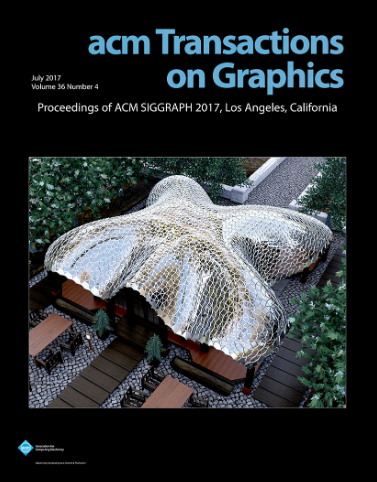Real-Time Knit Deformation and Rendering
IF 9.5
1区 计算机科学
Q1 COMPUTER SCIENCE, SOFTWARE ENGINEERING
引用次数: 0
Abstract
The knit structure consists of interlocked yarns, with each yarn comprising multiple plies comprising tens to hundreds of twisted fibers. This intricate geometry and the large number of geometric primitives present substantial challenges for achieving high-fidelity simulation and rendering in real-time applications. In this work, we introduce the first real-time framework that takes an animated stitch mesh as input and enhances it with yarn-level simulation and fiber-level rendering. Our approach relies on a knot-based representation to model interlocked yarn contacts. The knot positions are interpolated from the underlying mesh, and associated yarn control points are optimized using a physically inspired energy formulation, which is solved through a GPU-based Gauss-Newton scheme for real-time performance. The optimized control points are sent to the GPU rasterization pipeline and rendered as yarns with fiber-level details. In real-time rendering, we introduce several decomposition strategies to enable realistic lighting effects on complex knit structures, even under environmental lighting, while maintaining computational and memory efficiency. Our simulation faithfully reproduces yarn-level structures under deformations, e.g., stretching and shearing, capturing interlocked yarn behaviors. The rendering pipeline achieves near-ground-truth visual quality while being 120,000× faster than path tracing reference with fiber-level geometries. The whole system provides real-time performance and has been evaluated through various application scenarios, including knit simulation for small patches and full garments and yarn-level relaxation in the design pipeline.实时编织变形和渲染
针织结构由互锁的纱线组成,每根纱线由数十至数百根绞合纤维组成的多层组成。这种复杂的几何结构和大量的几何原语为实现高保真仿真和实时渲染应用程序提出了实质性的挑战。在这项工作中,我们引入了第一个实时框架,它以动画缝线网格为输入,并通过纱线级模拟和纤维级渲染来增强它。我们的方法依赖于基于结的表示来模拟互锁的纱线接触。从底层网格中插值结位置,并使用物理启发能量公式优化相关的纱线控制点,并通过基于gpu的高斯-牛顿方案进行实时性能求解。优化后的控制点被发送到GPU光栅化流水线,并渲染成具有纤维级细节的纱线。在实时渲染中,我们引入了几种分解策略,即使在环境照明下,也能在复杂的编织结构上实现逼真的照明效果,同时保持计算和内存效率。我们的模拟忠实地再现了变形下的纱线级结构,例如拉伸和剪切,捕获了互锁纱线的行为。渲染管道达到接近地面的视觉质量,同时比使用光纤级几何图形的路径跟踪参考快12万倍。整个系统提供了实时性能,并通过各种应用场景进行了评估,包括小补丁和完整服装的针织模拟以及设计流程中的纱线级松弛。
本文章由计算机程序翻译,如有差异,请以英文原文为准。
求助全文
约1分钟内获得全文
求助全文
来源期刊

ACM Transactions on Graphics
工程技术-计算机:软件工程
CiteScore
14.30
自引率
25.80%
发文量
193
审稿时长
12 months
期刊介绍:
ACM Transactions on Graphics (TOG) is a peer-reviewed scientific journal that aims to disseminate the latest findings of note in the field of computer graphics. It has been published since 1982 by the Association for Computing Machinery. Starting in 2003, all papers accepted for presentation at the annual SIGGRAPH conference are printed in a special summer issue of the journal.
 求助内容:
求助内容: 应助结果提醒方式:
应助结果提醒方式:


